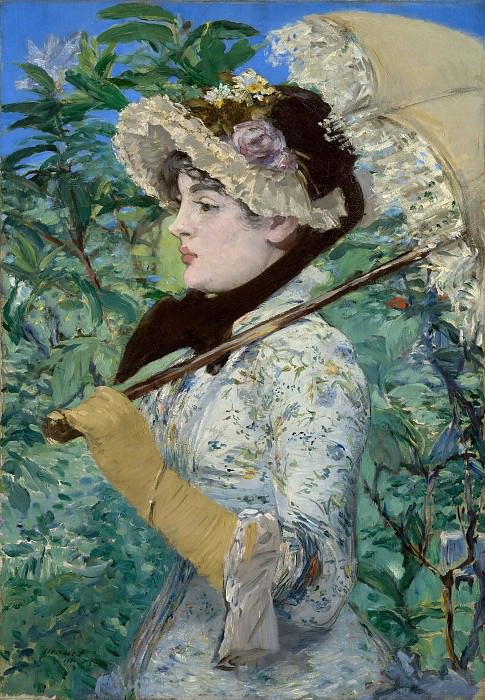Spring (Jeanne Demarsy) Édouard Manet (1832-1883)
Édouard Manet – Spring (Jeanne Demarsy)
Edit attribution
Download full size: 2520×3643 px (1,9 Mb)
Painter: Édouard Manet
Location: The J. Paul Getty Museum, Los Angeles.
One is even somehow lost at the sight of such a female image. You don’t know exactly how to define her condition. On the one hand, it seems to be a haughty coquette who knows how and knows how to behave in society. On the other hand, this is a girl who apparently recently lost someone close to her. And that’s why her eyes seem to cry, and that’s why the beautiful cap is covered by a black ribbon.
Description of Eduard Manet’s painting Jeanne (Spring)
One is even somehow lost at the sight of such a female image. You don’t know exactly how to define her condition. On the one hand, it seems to be a haughty coquette who knows how and knows how to behave in society. On the other hand, this is a girl who apparently recently lost someone close to her. And that’s why her eyes seem to cry, and that’s why the beautiful cap is covered by a black ribbon. But then why is the second title a spring? Strange.
But the girl, no matter what condition she’s in or what state she’s in, is beautiful. And yet about Spring... Perhaps the master was alluding to the fact that Spring can be rainy and even grumpy at times, but is wonderfully beautiful and young at the same time. But there is also a third understanding of the state of a girl - falling in love and the presence of black - the loss of a loved one or a temporary separation. Then the ladies possessed a peculiar technique or skill with gestures or objects of costume to hint at the state of mind. And experienced citizens understood what the girl was hinting at.
In the picture, the girl clearly didn’t want to communicate with anyone, at least for the moment. Maybe that’s why she still seems unapproachable in this view. Even if so, the girl should take a good break from the hustle and bustle of people. This solution clearly doesn’t work. And it only raises the level of tears in her eyes. And yet, there’s nothing mysterious about it. She’s just charmingly simple.
Manet, as always, is devoted to himself, that is, to his taste. Once again, he decorated everything in a floral palette. And the plants are present not only in the background of the canvas. They are, by the way, very dense. The dress of the girl also has a floral pattern.
Only two things remain monotonous: the gloves and the umbrella are pure beige. And at the same time, you can’t call the canvas bright, it’s just dulled by the background - still enough of the faded green coloring of plants.
Everything in this canvas is executed flawlessly and faithfully.
Кому понравилось
Пожалуйста, подождите
На эту операцию может потребоваться несколько секунд.
Информация появится в новом окне,
если открытие новых окон не запрещено в настройках вашего браузера.
You need to login
Для работы с коллекциями – пожалуйста, войдите в аккаунт (open in new window).




















You cannot comment Why?
This painting depicts a young woman, identified as Jeanne Demarsy, in profile, set against a backdrop of lush greenery and a bright blue sky. She is wearing a fashionable, wide-brimmed hat adorned with flowers and ribbons, and a light-colored dress with a delicate floral pattern. Her right arm is extended, holding a walking stick or parasol handle, and she wears a long, light tan glove. Her left hand, also gloved, is partially visible under the parasol.
The subtexts of this painting can be interpreted in several ways:
The Arrival of Spring: The title Spring directly suggests the theme. The vibrant greenery, the blooming flowers on her hat, and the bright, sunny atmosphere all contribute to a feeling of renewal and the flourishing of nature. The woman herself appears fresh and youthful, embodying the spirit of the season.
Bourgeois Leisure and Fashion: The womans attire – her elaborate hat, patterned dress, and gloves – speaks to the fashion and social customs of the late 19th century. The parasol, though not fully deployed, signifies outdoor leisure activities associated with the upper classes, particularly women, who were often advised to protect their complexions from the sun. The setting, likely a garden or park, further reinforces this idea of a leisurely outing.
A Moment of Transition or Contemplation: Her gaze is directed outward, perhaps towards something unseen, suggesting a moment of quiet observation or introspection. The profile view can sometimes imply a sense of reserve or a focus on internal thoughts rather than outward engagement.
Impressionist Style and Light: As an Impressionist work, the painting emphasizes the capturing of light and atmospheric conditions. The brushwork is visible and energetic, especially in the rendering of the foliage, creating a sense of immediacy and the fleeting nature of a moment. The bright sky and dappled light on the foliage are characteristic of Impressionist interest in outdoor scenes.